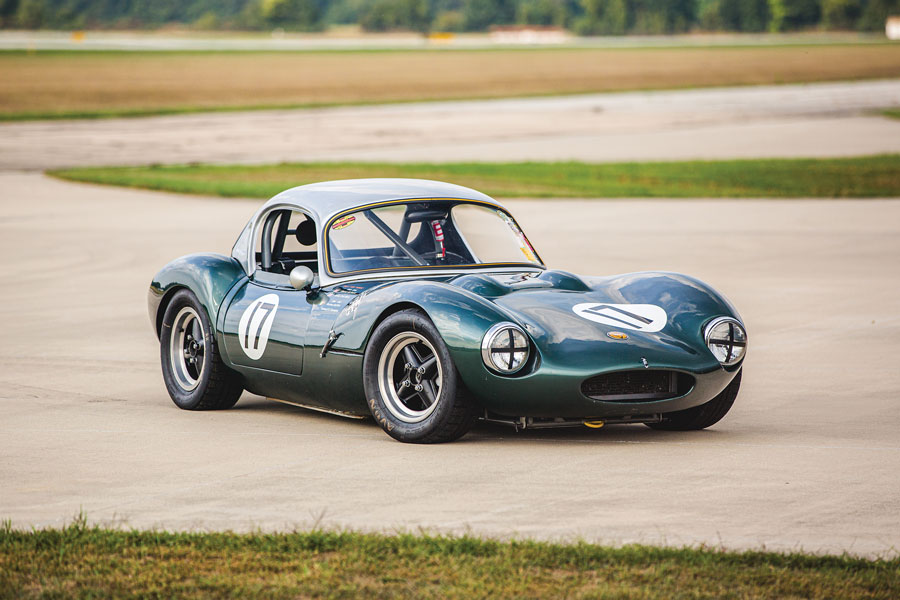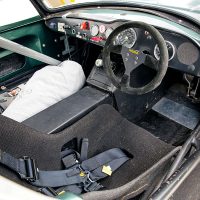- Among the most famous and documented racing Ginettas
- The Chris Meek/Gil Baird “Works” development and competition car
- Numerous wins at Silverstone, Snetterton, Mallory Park and other venues
- One of only two Lotus Twin Cam-powered G4Rs to race internationally
- Featured in all the books written on the Ginetta marque
- Restored for and vintage-raced by previous owner
SCM Analysis
Detailing
| Vehicle: | 1964 Ginetta G4R |
| Years Produced: | 1965 |
| Number Produced: | 10–12 G4Rs |
| Chassis Number Location: | Tag on firewall |
| Engine Number Location: | By distributor |
| Club Info: | Sportscar Vintage Racing Association |
| Website: | http://www.svra.com |
| Alternatives: | 1964–66 Lotus 26R, 1954–65 Marcos GT, 1964 TVR Grantura |
This car, Lot 2169, sold for $151,200, including buyer’s premium, at RM Sotheby’s Elkhart Collection sale in Elkhart, IN, on October 24, 2020.
Quite obviously, all Ginetta G4s are not created equal. Even at the height of the vintage-racing car market a decade ago, $85,000 was all the money in the world for a quick G4R. I know of a well-prepared standard G4 that could be had for $30,000 today. And in fact, another G4 sold for $31,360 at the same sale.
And yet, a (presumably) fully rational and knowledgeable buyer chose to spend a lot more on this one. We should probably spend a little time unpacking why.
Ginetta 101
Let us start with some background on Ginetta. The company was formed in the U.K. in the late 1950s by the four Walklett brothers. It was a sideline to their structural-engineering business, primarily fueled by the youngest brother’s desire to build a racing car. By the late 1960s, building automobiles had become the company’s primary focus.
Tiny and gorgeous, the Ginetta G4 was a street-drivable race car. Based on a light, strong and complex tubular chassis that was bonded to the body’s fiberglass center section for increased torsional stiffness, it was the hit of the January 1961 Racing Car Show in the U.K. With a double-wishbone front suspension and a Ford Anglia rear axle located with trailing arms, it employed coil-over springs and shocks at both front and rear. The powertrain was also Ford Anglia-derived.
The G4 was available either as a completed car or as a kit, which avoided the rather usurious new-car tax in England. Many (if not most) of the G4s were sold in kit form, so power tended to come from whatever the owner could afford. This ranged from a 1,000-cc Anglia mill to a 1,500-cc Cortina engine.
Did I mention that the G4 was tiny? At 11 feet long, under five feet wide, and just 42 inches tall, the car weighed in at only 1,000 pounds. This made for an advantageous power-to-weight ratio. The downside was that if you were over 5-foot, 9 inches, you had the “long, tall Texan in a roller skate” problem. This was more an issue for Americans, of course, than for the typical English racer.
Improving the breed
By 1964, the G4 had received an Austin/Morris rear-axle swap — slightly wider and with more available ratios. The car was proving to be a major competitor in English national-level racing. The factory fielded a race team using Chris Meeks as driver, and he asked if they could devise an independent rear suspension to replace the live axle.
Brother Ivor Walklett worked out a new design that retained the BMC “pumpkin,” but used tubular wishbones and trailing arms with coil-over shocks and springs. Thus, a light and effective IRS was created. The disc brakes were moved inboard to save unsprung weight, and the new car got a Lotus Twin Cam racing engine.
Introduced in early 1965, this new configuration was called the G4R. It was a true giant killer. There are wonderful stories of in-period David and Goliath battles between a G4R and a Ferrari 250 LM. The Ferrari tended to win, but not by much.
There was also a third G4 variant. In 1965, Ginetta switched from round chassis tubes to square ones to make construction of the 300-odd chassis pieces easier. Thus, we have “round-tube” and “square-tube” chassis types. I don’t know that one is functionally better or worse, but the round-tube chassis are more desirable.
All-in, Ginetta built about 300 G4s back in the day (and you can still buy a brand-new continuation model if you want). Somewhere between 10 and 12 were G4R models, all of which were round-tube cars.
Quick, capable and not so valuable
That’s pretty much the G4 story. We had one back in the ’90s, and I can attest that they are a giggle to drive, strong and easy to keep running. These are definitely weapons-grade cars, and there are a lot of them extant. As such, they are not wildly valuable.
If any G4 has collector value, however, it is our subject car. RM Sotheby’s has the car listed as a 1964 rather than a ’65, possibly due to its role as the factory development car. Regardless, it was campaigned as a factory entry in 1965 and was quite successful, netting seven wins, plus a 2nd-, and 4th-place finish. The car went to Ireland for the 1966 season and took another seven victories and a 2nd-place trophy. It is easily the most important example of all Ginetta G4s.
The question is whether that history is worth a premium price, and the answer apparently is yes. This valuation is buoyed by the question of alternates, as a good Lotus Elan 26R would cost at least this much and be far more difficult to maintain and race.
In the end, the buyer of this car spent a ton of money but got a great and important racer. It was expensive, but probably a rational purchase nonetheless. ♦
(Introductory description courtesy of RM Sotheby’s.)



